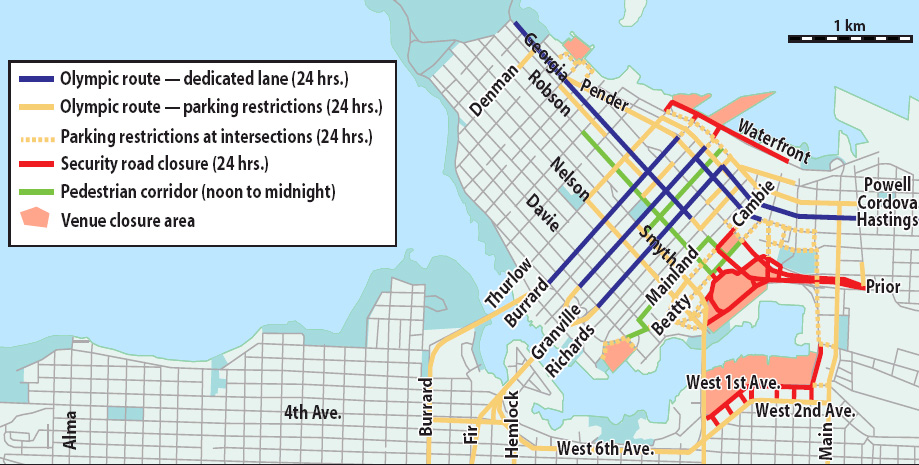Transit system will be pushed to limit but we have a plan: Officials
Damian Inwood
Province

A fleet of 180 transit buses will be ready to ride to the rescue if Metro Vancouver’s transit system overloads during the Vancouver 2010 Games.
And if the Sea-to-Sky Highway is blocked by a major rock slide, B.C. Ferries vessels will be on standby to shuttle Olympic traffic to Darrell Bay, near Squamish.
These are two of the measures to stop traffic gridlock that were outlined Wednesday in a detailed briefing on Olympic transportation.
While Doug Kelsey, the region’s Olympic transit planner, said he’s confident the transit plan will work, he cautioned people to be ready for delays during the Games.
“There are going to be lineups,” he said. “To think that everyone’s going to get on a bus or a train and there won’t be lineups at different points of time is not realistic. The system will be taken to its highest level ever.” Expanded transit is a key element in the 2010 transportation plan, which was unveiled in detail Wednesday.
It includes times of road closures, the introduction of Olympic lanes, parking restrictions and a vehicle checkpoint on the Sea-to-Sky Highway.
To prevent downtown Vancouver being gripped by gridlock, it’s imperative to get 30,000 cars off the road every day of the 17-day sporting event.
Kelsey said transit planners learned from previous Games and decided to put the 180 new buses at different points across the Lower Mainland and keep some in reserve if the system chokes up.
“In case of [passenger] surges, mechanical breakdowns, weather issues — there’s a whole menu of things — we’ll deploy those,” he said. “If Vancouver has significant stresses downtown, we might have ‘turn-backs.'” That might mean that buses can’t get into the downtown core.
Kelsey said commuters should plan for trips to take longer during the Olympics.
“If you have tickets for opening ceremonies and you think you might do what you do for a normal Vancouver Canucks hockey game and walk down there while they’re singing the anthem, you’re going to miss your event,” he warned.
Vancouver city manager Penny Ballem said she’s “confident” that there won’t be gridlock during the Games.
“We know that a successful transportation plan is fundamental to the perception of the success of the Olympics,” she said.
Ballem said that 150,000 extra people are expected to flood downtown on any given Olympic day, more than the 125,000 residents who live there.
“We have a public information plan starting on Oct. 19 to help our citizens understand that they will have to make plans and will have to change how they do things,” she added.
Terry Wright, 2010’s boss of Olympic services, said officials are still fine-tuning transportation plans for the Feb. 12 opening ceremonies.
“It’s an all-hands-on-deck day,” he said. “It’s a day when all the media wants to come, where we bring all the athletes in, where we have the stadium full of spectators and we have our sponsors, all of our international dignitaries, heads of state and so on.” Wright said the busiest place during the Games will be the east end of False Creek, where GM Place, B.C. Place, the Olympic Athletes Village and two party plaza sites are located.
Keeping the Lions Gate and the Ironworkers Memorial Second Narrows bridges open are key pieces of the plan.
Supt. Kevin deBruyckere of the Vancouver 2010 Integrated Security Unit said a lot of work is being done to prevent the lengthy bridge shutdowns due to suicide attempts.
He said putting nets under the bridges, similar to those used in San Francisco had been considered.
“We’ll have a significant increase in uniformed, visible policing presence at or near the bridges,” he said. “Hopefully, that will provide a strong deterrent.” Mike Proudfoot, assistant deputy transportation minister, said that nets won’t be used during the Games, but are being studied as a future measure.
They would cost “tens of millions” to install, he said.
© Copyright (c) The Province

